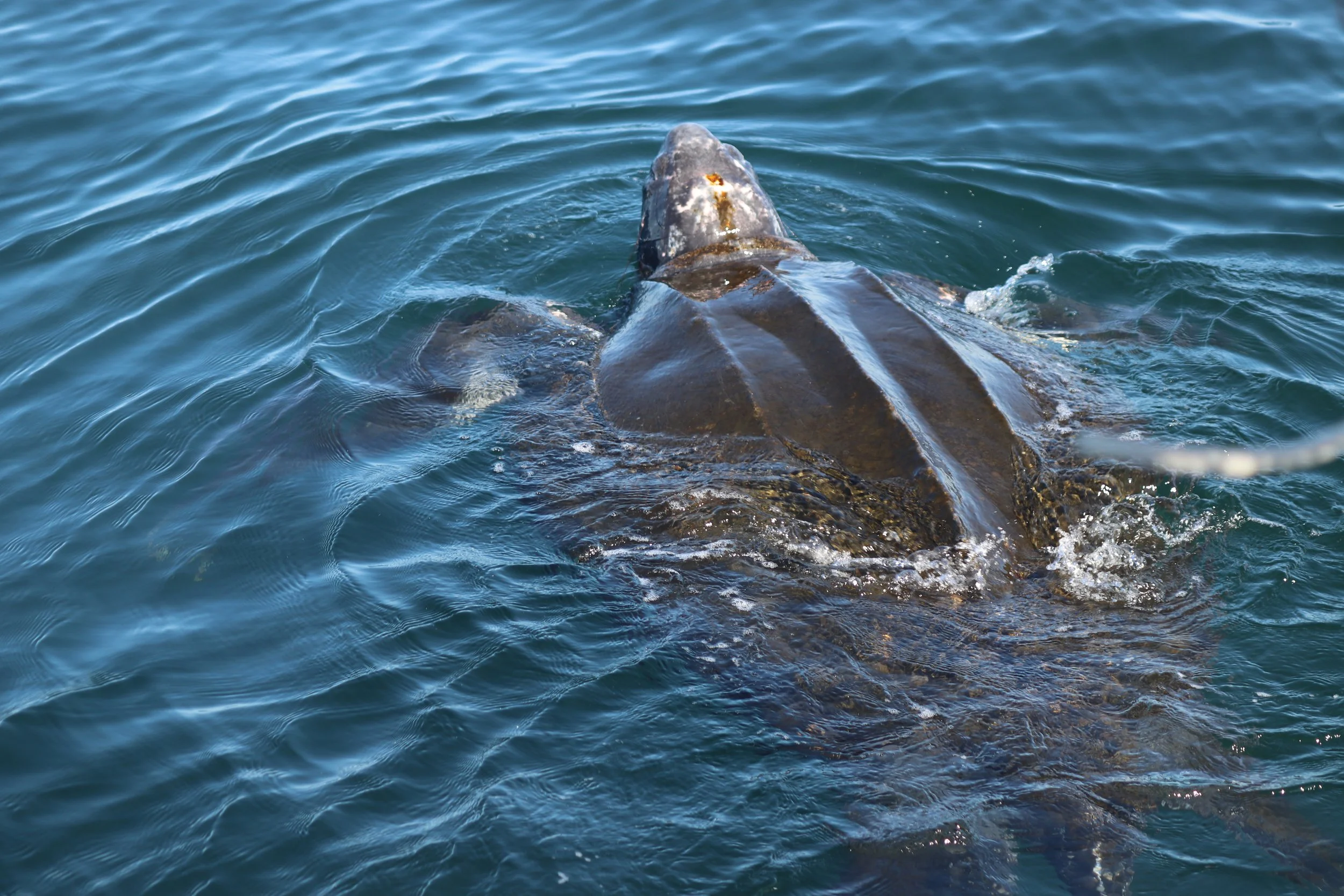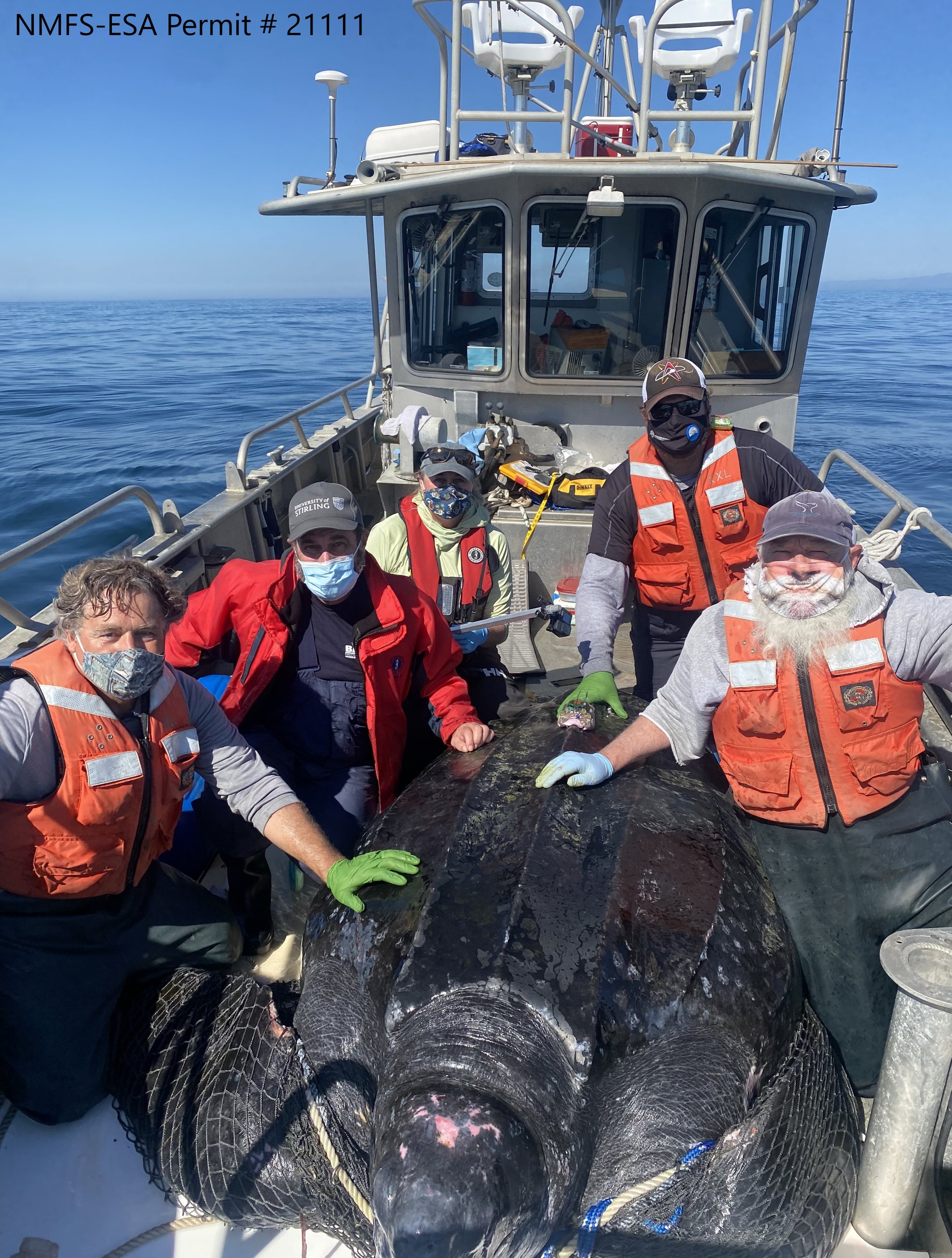Nonprofit organization Upwell and NOAA Fisheries are monitoring and protecting California’s leatherbacks with satellite technology
Pillar Point, CA November 8, 2021 - Researchers in October captured a massive Pacific leatherback turtle off California that they had caught and released once before in 2016. In late October, a collaborative team of researchers from the nonprofit organization Upwell and NOAA’s National Marine Fisheries Service (NOAA Fisheries), set out in search of California’s elusive leatherback sea turtles. Their intent was to use satellite and acoustic tags to track leatherback movement patterns and reduce risk of entanglement in fishing gear. It wasn’t long before the aerial survey crew radioed the vessel team to report a large leatherback five miles northwest of Pillar Point Harbor in Half Moon Bay, CA.
The vessel team located the 1,419 pound (645 kg) male leatherback and brought the massive animal on board for tagging and veterinary assessment. Upwell Executive Director Dr. George Shillinger noted, “While leatherbacks can reach up to 2,000 pounds, it’s incredibly rare to encounter one so large in the foraging grounds off the coast of Central California, or anywhere, for that matter. Additionally, most tagging operations take place at nesting beaches with females only, so it’s extraordinary to have the opportunity to tag a male leatherback, especially one of this size.”
Photo: John Douglas, Moss Landing Marine Lab, NOAA Fisheries Permit #21111
As the team quickly set about their work, NOAA Fisheries’ researcher Scott Benson recognized the distinctive shape of the leatherback’s carapace. Two unusual bumps on the rear part of the carapace indicating a possible healed injury from a ship strike seemed familiar to Benson. A flipper tag and scan for a Passive Integrated Transponder, much like the microchips used on pets, confirmed this wasn’t the first time this particular turtle had been captured and tagged by Benson’s team.
In 2016, Benson had encountered this very same leatherback while on a tagging expedition off the coast of California. He had just three tries to capture and bring the animal on board, as per the terms of his permit, but was not successful on the first day - in part because of the large size of the animal. Miraculously, the team was able to locate the turtle the following week and successfully captured the turtle. While leatherbacks in the study typically receive a number rather than a name, the distinctively healed, bumpy carapace led the team to nickname the leatherback “Bumpy”.
Upwell’s Wildlife Veterinarian Dr. Heather Harris confirmed Bumpy was in excellent health despite the old healed parallel lacerations on the caudal carapace that indicated a previous propeller injury from a boat strike. Harris noted, “Every opportunity to examine a leatherback provides a valuable window into the health threats facing this critically endangered population. The fact that Bumpy's injuries have healed completely and his body condition has improved significantly since our first encounter highlights the incredible resilience of these animals.”
The recapture of Bumpy in October 2021 is only the second time that a previously tagged West Pacific male leatherback has ever been encountered and captured again in the foraging grounds. It also marks the first occasion on which an acoustic tag has been deployed on any leatherback in the California Current Ecosystem. Acoustic tags transmit data to receivers, typically affixed to buoys placed in key offshore locations by researchers studying the movements of fish, marine mammals and, now, leatherback turtles. The benefit of acoustic tags is that they typically transmit much longer than satellite tags. We may be hearing from Bumpy for years to come each time he passes an acoustic receiver.
Shillinger stated, “The long-term monitoring efforts, including aerial surveys, sampling, and electronic tracking studies using both satellite and acoustic tags, will enhance our understanding about how Pacific leatherback turtles utilize habitats within the California Current Large Marine Ecosystem. This data has immediate implications for leatherback management and conservation.” The data collected through aerial surveys and satellite tags is used by the California Department of Fish and Wildlife and the Dungeness Crab Fishing Gear Working Group to assess and mitigate the risk of leatherback entanglement in Dungeness crab fishing gear. The team provides regular updates to CA State’s Risk Assessment and Mitigation Program (RAMP) to help inform the opening of crab season.
Benson added, “We work closely with the State of California and the fishermen to help assess whale and leatherback entanglement risk prior to the opening of the Dungeness crab fishing season. Obtaining aerial survey and telemetry data at regular intervals is key to allowing the fishery to open as early as possible without posing undue entanglement risk to endangered leatherbacks and whales.”
Map: Scott Benson, NOAA Fisheries
Bumpy the leatherback is now situated along the northwest edge of the Monterey Canyon and has likely begun his epic migration back across the entire Pacific Ocean to the coastal waters of Indonesia, the Solomon Islands or Papua New Guinea to find a mate. With the help of satellite technology, the Upwell and NOAA team will be watching him along his journey.



